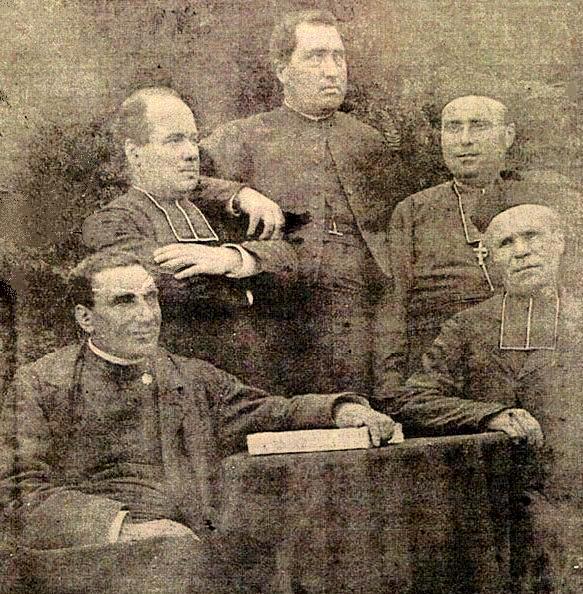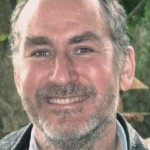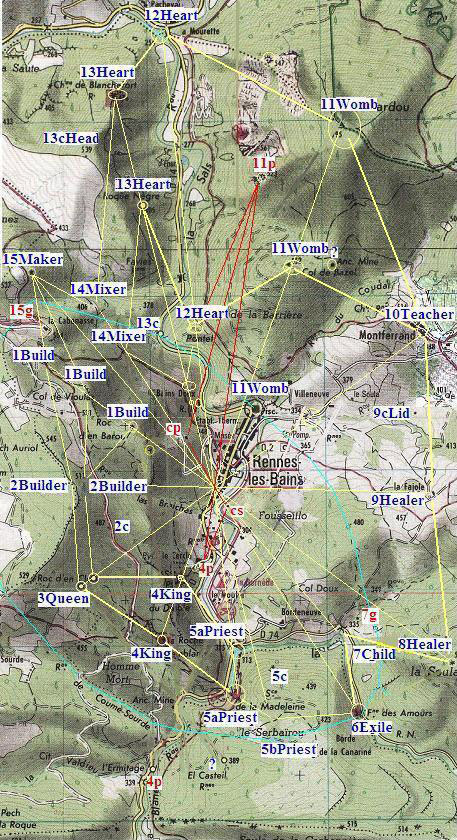Within layers of hoaxes, hype, history, legend and myth, we subconsciously imprint one specific pattern in all cultural sites. The archetypal structuralist model reveals that blueprint among apparently haphazard resources, buildings and events in every village and city. Rennes le Chateau’s Visigothic, Merovingian and modern layers, and Rennes les Bains’ Roman and Frankish layers, each added some archetypal features to the structure of the place.
Ancient settlers of the Two Rural Rennes made salt near Mount Bucharach, washed in hot sources along the lower Sals river, and traded at the Occitan Aude river market that became Couiza. Romans built baths at Rennes les Bains, a road, and a stopover at L’Escale about BC 60. Couiza’s Visigoth monks built a castle and church on the inviting Rennes le Chateau citadel in their grazing fields about AD 414. Some Medieval political, military, religious and esoteric intrigues played out in the area. Rennes les Bains priest Henri Boudet made the first systematic description of the soul of the place. In ‘True Celtic language and the stone circle of Rennes les Bains’ (1886), Boudet fused place names, amateur ‘Druidic’ etymology and puns, and localised Pliny’s ‘Celtic’ calendar into his valley landscape as ‘twelve palaces, caskets or drawers locked in a wheel, grinding corn perfectly’. Calibrated in English miles, his vision had a 17 km circumference, implying a 5.5 km diameter cycle, but without month or zodiac labels.
Boudet’s Anglo-Frankish correspondence theory came closer to subconscious truth than any of the conspiracy theories imposed here by visionaries and novelists since the 1950s. Archaeo astronomer Alexander Thom noted “a pattern in the landscape” at Rennes, but did not identify it. Rennes le Chateau church domain owner Noel Corbu revived public interest in Templar gold by hyping priest Saunière’s treasure. Pierre Plantard, a draughtsman who had been inventing ‘societies’ since before WWII, constructed the Rennes pseudo-history. His Red Serpent pamphlet adapted alchemical emblematic verses about the ‘Red Sea’, and re-cycled Boudet’s book into a horse-ride among landscape ‘constellations’. His ride does not fit the landscape in any regular pattern, despite Brouillard’s 2009 attempt to demonstrate it as a series of chess moves. No consistent ‘zodiac map’ had emerged in this or any landscape, despite 70 years of ‘correspondence’ effort, including JJ Artficier on Staticblog4ever; Wayne Herschel on Hidden Archives; and again Plantard, or a retro-hoaxer using his name, on Zodiac of Rennes. Paul Smith (2018) placed Boudet’s ‘twelve caskets’ around Bains, and around the Rennes church floor. All these schemes differ entirely from one another, and from the current identification of archetypal features.
Popular science and popular culture assume that any recurrent behaviour is consciously invented or borrowed, learned and diffused. But the archetypal structuralist model offers hundreds of examples of individual and collective subconscious re-expressions of a specific pattern, and small sets of optional features, each appearing at a specific average frequency in cultural media worldwide; unaffected by theological, political, academic or esoteric agendas. Apparent ‘cultural’ diversity is little more then stylisation. But we are equally hard-wired to ignore this pattern in favour of our egotistical image as ‘creators’ of built sites, and even of media and of meaning itself.
In Rennes les Bains and Rennes le Chateau, the subconscious blueprint was demonstrated in the Rennes le Chateau church Sermon on the Mount mural of 3m diameter; church floor plan of 8m x18m; presbytery ground of 60x90m (Furter 2019); and two landscapes of 4km diameter each, as interlinked flattened ‘spheres’. These indicate that correspondences are due to hard-wired behaviour, not to imitation or conspiracy.
Rennes les Bains river basin imprint
All artworks, built sites, alphabets and other cultural sets, express twelve or sixteen types (each with certain optional features); in peripheral sequence; with an axial grid between their eyes or focal points; around five polar markers on junctures or limb joints; one of which is oriented to the implied solstices of the cultural time-frame. The archetypal model uses a standard format to compare structuralist data. Here is the Rennes le Bains landscape version.
Type label; Site features (noting global archetypes):
- 1 Builder; Head of Man, probably a Roman water goddess (rain), or Mitra, ‘Bond’, rock-born (builder, hero), named lightning bolt (rain, ruin), bull-killer (bovid, twisted posture, spring sacrifice). Boudet moved it to his presbytery, now a museum.
- 2 Builder; Halo cliff, Auriol, equinox sunsets (former spring. Other type 1 and/or 2 optional features include cluster, bird, tower, book or maze).
- 2c Basket; Cross of the Circle. And Clots ruin, where Brouillard (2009) found a small cavity (container, secret) in a pilaster holding a thin slab with chisel marks (texture. Other 2c features include weave or snake. C-types are not on axes, but between certain axes.).
- 3 Queen; Mud Rock (pool). And Caunes, Cave (more typical of 2), or Shrine (priestess) in Occitan, draining into Clinck Health Bottle (2c container). And Ejaculation Source (pool, spring season. Other type 3 features include bent neck, dragon, sacrifice, school).
- 4 King; Trembling Rocks or Rollers that Boudet labelled ‘Druid Council, Neimheidh,’ adding bad puns on ‘Neim, Name, Lead (king); Eid, Dei, God; H, Homme, Man’. And Devil’s Throne (king). And castles at Bezu, White Fortress (rectangles, walls). A Voisins mansion here became a Catalan command, with ditches and wood wall (wall). Re-melted gold (furnace) was found here. Voisins and Fermes families minted counterfeit coins (king. Other type 4 features include squatting, twins, sun).
- 4p Galactic South Pole; The Circle, a natural formation partly under a house (juncture). Boudet saw it as the centre of a mill, but it is one of five polar markers. And Circle Source, a rusty trickle (spout). Its large Visigoth vase is now in the museum. And Hermitage, stone walls under an overhang (juncture) at Blanque river ford (juncture). A modern stepping stone (juncture) in the stream (water) is engraved with dragonflies mating (limb-joints) as interlocked spirals (juncture) around an ankh head. And Castle ruin.
- 5a Priest; Magdalene Source (water). Assumed female initiation site (priestess, ritual, assembly). Boudet says it was Gode, Grail (priest), in the land register. And Blanque-Sals confluence ‘Baptismal Font’ (priest, ritual, container, assembly, water), under a bridge. Mixture (5 varicoloured) of 6 Lovers source, 5 sulphur ‘tears’ and 3 Mud trickle into Salt river. Bains is a kind of Jordan and Jerusalem (Sylvain 2015).
- 5b Priest; Serbairou foothill sports ground (assembly, ritual). Boudet’s only mapped ‘dolmen’ (5c container) is near the river. He adds a chapter on boar hunt and Hercules with his lion cape (felid, of 13 opposite) and twelve tasks (hyperactive) as punishment (judgement. Other type 5 features include tailcoat-head, horizontal, ascension).
- 5c Basket Tail; Serebairou Gode, Grail (container). And New Inn. And Yellow Inn (5 varicoloured. Other 5c features include weave).
- 6 Exile; Lovers Source (marriage). Relief of salamanders entwined (double-headed. Other type 6 features include ingress /egress, horned, U-shape, double-headed, caprid, tree).
- 7 Child; Forest stream confluence. And Sweet Hill. (Type 7 features include rope, juvenile, bag, unfold, chariot).
- 7g Galactic Centre; Corral or ruin. (Type 7g features include juncture, water, path, gate).
- 8 Healer; Soulane Hill stones (pillars). And Mines (metal). And Sougraine salt works (healer). And Salette, where two girls saw a vision of Magdalene Penitent (healer).
- 9 Healer; Fajole Shepherds, Fallen Stones (bent, pillars. Other type 8/9 features include strong, disc, smelt).
- 9c Basket Lid; Soul grain silo (container). And Kairolo, Cereal. Boudet added puns on Calendar (10 wheel), Secret (revelation), Key (container), Ear (oracle) and Hole (silo). And Lime Tree in the church graveyard, perhaps a survey hub (10 wheel. instrument. Other 9c features include disc, weave).
- 10 Teacher; Montferrand, Iron Mt (metal), first village (market) in the basin, at Captee, Gathered [ore] (metal). Former Roman tower (guard) for Bazel mine, used by Visigoths and Cathars, later a Frank castle (guard). And Villeneuve. And Bains church of Sts Nazaire and Celse. And Town Hall (council. Other type 10 features include raised arms, staff, hunt master).
- 11 Womb; Cardou Peak, high, rounded (womb), from Chardons, Thistle or spikenard of Magdalene. Mines and a rumoured tomb (tomb). And Bazel hill gold mine (womb), rumoured tomb (tomb). And Delmas Cross at village cliff, rumoured tomb (tomb). And Queen’s (womb) Baths. And Roman Deposition Wall for crimes (law). Boudet found a Venus statue (womb) in house Chaluleau. And Pontils stone. And ‘Poussin’s Arcadia’ tomb. Nostradamus noted ‘a great Roman’s grave’, perhaps of Philip Augustus, named after an emperor (grave. Other type 11 features include wheat, water, library).
- 11p Galactic Pole; Lambs, white rocks and mine waste (juncture). And Serres, Hothouse or Sun, village split by a bridge (juncture), on the Paris meridian (juncture). On St Peter’s church ceiling are two connected crosses set on rocks, perhaps Christ and Peter, or Paris and St Sulpice meridians, or Pachevan and Pontils tombs. Nostradamus, who had lived in nearby Alet les Bains in his youth, noted a tomb ’beside the pavilion [Pachevan?], near the greenhouse [Serres?], where the wild beast lay [Arcadia?].’
- 12 Heart; Sals-Rialsesse confluence, salt into fresh (water-work). And Pontet source, on Barrier Hill (bastion), into a pipe (water-work).
- 13 Heart; Blanchefort lookout ruin (bastion), over a tunnel, cistern and hand-pump (heart, water-work), a 900s Visigoth post (war) or Roman salt tax base. Templars claimed to re-open a gold mine 1156, using German smelters, perhaps to re-smelt Arabic booty. And Black Rock, a mine (interior), water tunnel, legendary underground round temple (rounded) or buddling tank (water-work). And Rabbit Warren (interior). And Sweet Bath hot source into a pipe (water-work). Boudet labels it ‘Escape from Gallows’ (death. Other Type 12/13 features include felid, invert, weapon).
- 13c Basket Head; Finger Rock. And Favies spring shrine (oracle). And Blanchefort peak west former fort (13 bastion. Other 13c features include lid or weave).
- 14 Mixer; Cassaigns. And path below Cabanasse, near the axial centre (ingress. Other type 14 features include time, tree, angel, bird).
- 15 Maker; Coumes Fountain rock. And Mouscairol. (Type 15 features include churn, rope, order, bag, mace, doubled, canid, face, sceptre).
- 15g Galactic Gate; Cabanasse, Cabin, Tent (15 bag, rope), and stone cross Cugulhou, Windbreak, Jacket (15 bag. Type 15g features include juncture or limb-joint).
- Axial centre; Village edge (juncture) behind the Post Office.
- Midsummer; Shepherd’s House track end (juncture), or Doux hot spring.
- Midwinter; Isolated building on the east bank.
These polar markers place midsummer on axis 13 Leo or 13-14 Leo-Cancer, implying spring and the cultural time-frame in Age Taurus or Age Taurus-Aries. The transition was about BC 80, between Imperial Roman and Republican Christian Ages. The general theme in this landscape includes type 2c Basket of Mysteries, here in the Breiches knoll sector; and type 9c Lid, here in the Soul and Granary sector. The layers of structuralist features of cultural expression are subconscious.

Rennes les Bains type 6, the Lovers source (photo after Canalblog). Top right is a water mill remnant. Just below it is a small modern flat niche with engraved salamanders.

Rennes les Bains type 11, the Delmas Cross at the village entrance cliff (photo after Google Street).
Nature informs culture
A ragged equator of sites makes the Rennes les Bains basin a concave, lower sphere of waters ‘under the earth’, next to the plateau around Rennes le Chateau knoll as an upper sphere. Their spheres are ‘geared’ to one another, since five Bains axes and five Rennes axes meet at five shared features, on these type axes: 14 Cassaignes village; 15 Mouscairol at Wolf Pass; 1 Brugos hairpin track; 2 Halo cliff Auriol; 2c La Maurine; 3 Ejaculation Source.
The Rural Rennes axial grids include several natural features, indicating an ‘Arcadia’. Nature has many media of structuralist expression, while culture has to borrow and collaborate. Both domains use replication with some variation, indicating a natural pattern. The archetypal model raises that pattern to conscious study, and resolves conspiracy theories.

Rennes les Bains priest Henri Boudet (middle right), author of ‘True Celtic language’. On this Carcasonne Seminary reunion photo (scan after Terre de Rhedae) are Bérenger Saunière of Rennes le Chateau; Maurice Malot of Grèzes, Alfred Saunière of Narbonne where he worked for the Chefdebien family; Boudet; and Antoine Gelis of Caustaussa, who was murdered in his church in 1897.
References
Brouillard, G 2009. Discovering the keystone, Red Serpent. Griffel
Furter, E. 2014. Mindprint, the subconscious art code. Lulu.com
Furter, E. 2016. Stoneprint, the human code in art, buildings and cities. Four Equators Media
Furter, E. 2017. Recurrent characters in rock art reveal objective meaning. Expression 16, June. The message behind the image. Atelier Etno.
Furter, E. 2019. Stoneprint Journal 6; Rennes le Chateau stoneprint tour. Lulu.com.
Gough, A. Arcadia blog, Memento Mori: the Story of London’s Elysian Fields.
Liliendal, K. Blanche-Negre.
Plantard, P. 1978. Preface to Boudet: True Celtic language. Belfond.
Smith, P. 2017. Rennes-le-Chateau and Paschal Full Moon, Station XIV.
Sylvain, P; Ulpian. 2015. Advent; Jesus Christ Barabbas. Editions S&T.
Wineyard, Val. Rennestimestwo.
This article is an extract from Edmond Furter’s Stoneprint Journal 6; Rennes le Chateau Stoneprint Tour (2019. Lulu.com). He is the author of Mindprint, the Subconscious Culture Code (2014. Lulu.com), and Stoneprint, the Human Code in Art, Buildings and Cities (2016. Four Equators Media). Stoneprint Journal explores archaeoastronomy and structuralist anthropology. Visit Stoneprint Journal Blog and Mindprint Art.









I am curious, are the axial centres of sites on any specific type of building, or place?
If there are two axial grids on a site, do they share some points or do they interlink without sharing points. Could they be completely independent of each other? Do they both go clockwise /counter-clockwise, or would one be clockwise and the other counter clockwise?
I Replied here, but the Reply function may be delayed?
Axial centres are usually (about 58%) apparently unmarked. Each of the six polar points has a specific average frequency for being on a limb joint in artworks, or a juncture, such as a corner, in building sites.
Double imprints always share from one to about five points, thus their sequences contra-rotate, like gears. If they are independent, they are not a pair, and their sequence could run in either direction. See the two Rennes example on Stoneprintjournal.